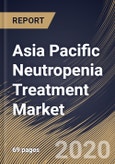The Asia Pacific Neutropenia Treatment Market is expected to witness market growth of 7.6% CAGR during the forecast period (2020-2026).
Neutropenia itself has no specific symptoms but is usually treated with a fever or infection. Often, persistent infection is also what leads doctors to test blood cell counts to identify blood cell cancers such as leukemia. Severe infections can develop quickly when a patient is neutropenic and become overwhelming within minutes to hours. Fortunately, since doctors expect potential changes in immune responses during multiple cancer treatments, they pay careful attention to variations in blood counts to avoid these events.
Cytotoxic chemotherapy can cause severe and often prolonged neutropenia, which can lead to Retailization for fever care or possibly fatal infection. While deep sustained neutropenia is more likely to occur in the pre-engraft process of hematopoietic cell transplantation and in patients undergoing acute leukemia induction therapy, chemotherapy-related neutropenia that also occurs in patients undergoing standard-dose chemotherapy for certain neoplasms. To eliminate infectious risks, recombinant human granulocyte stimulating factor (G-CSF; filgrastim and pegylated filgrastim) and granulocyte-macrophage stimulating factor (GM-CSF; sargramostim) have been used to decrease the length and degree of neutropenia.
A rise in the prevalence of leukemia, an increase in R&D activities and the production of new drugs, and a paradigm change from branded drugs to biosimilars in cancer-friendly treatment, are transforming the global neutropenia treatment industry. Nevertheless, high costs for the diagnosis of neutropenia and stringent rules for the clearance of products hinder the growth of the market. On the contrary, the robust neutropenia drug pipeline will open up new opportunities for market players over the coming years.
Based on Distribution channel, the market is segmented into Retail pharmacies, Hospital pharmacies and Online pharmacies. Based on Treatment, the market is segmented into Colony-stimulating factor, Antibiotics, Antifungals and Antivirals. Based on countries, the market is segmented into China, Japan, India, South Korea, Singapore, Malaysia, and Rest of Asia Pacific.
The market research report covers theanalysis of key stake holders of the market. Key companies profiled in the report include Amgen, Inc., Novartis AG, Pfizer, Inc., Teva Pharmaceuticals Industries Ltd., BeyondSpring, Inc., Spectrum Pharmaceuticals, Inc., Kyowa Kirin Co., Ltd. (Kirin Company), Mylan N.V., Cellerant Therapeutics, Inc., and Partner Therapeutics, Inc.
Scope of the Study
Market Segmentation:
By Distribution Channel
By Treatment
By Country
Companies Profiled
Unique Offerings from the Publisher
Neutropenia itself has no specific symptoms but is usually treated with a fever or infection. Often, persistent infection is also what leads doctors to test blood cell counts to identify blood cell cancers such as leukemia. Severe infections can develop quickly when a patient is neutropenic and become overwhelming within minutes to hours. Fortunately, since doctors expect potential changes in immune responses during multiple cancer treatments, they pay careful attention to variations in blood counts to avoid these events.
Cytotoxic chemotherapy can cause severe and often prolonged neutropenia, which can lead to Retailization for fever care or possibly fatal infection. While deep sustained neutropenia is more likely to occur in the pre-engraft process of hematopoietic cell transplantation and in patients undergoing acute leukemia induction therapy, chemotherapy-related neutropenia that also occurs in patients undergoing standard-dose chemotherapy for certain neoplasms. To eliminate infectious risks, recombinant human granulocyte stimulating factor (G-CSF; filgrastim and pegylated filgrastim) and granulocyte-macrophage stimulating factor (GM-CSF; sargramostim) have been used to decrease the length and degree of neutropenia.
A rise in the prevalence of leukemia, an increase in R&D activities and the production of new drugs, and a paradigm change from branded drugs to biosimilars in cancer-friendly treatment, are transforming the global neutropenia treatment industry. Nevertheless, high costs for the diagnosis of neutropenia and stringent rules for the clearance of products hinder the growth of the market. On the contrary, the robust neutropenia drug pipeline will open up new opportunities for market players over the coming years.
Based on Distribution channel, the market is segmented into Retail pharmacies, Hospital pharmacies and Online pharmacies. Based on Treatment, the market is segmented into Colony-stimulating factor, Antibiotics, Antifungals and Antivirals. Based on countries, the market is segmented into China, Japan, India, South Korea, Singapore, Malaysia, and Rest of Asia Pacific.
The market research report covers theanalysis of key stake holders of the market. Key companies profiled in the report include Amgen, Inc., Novartis AG, Pfizer, Inc., Teva Pharmaceuticals Industries Ltd., BeyondSpring, Inc., Spectrum Pharmaceuticals, Inc., Kyowa Kirin Co., Ltd. (Kirin Company), Mylan N.V., Cellerant Therapeutics, Inc., and Partner Therapeutics, Inc.
Scope of the Study
Market Segmentation:
By Distribution Channel
- Retail pharmacies
- Hospital pharmacies and
- Online pharmacies
By Treatment
- Colony-stimulating factor
- Antibiotics
- Antifungals and
- Antivirals
By Country
- China
- Japan
- India
- South Korea
- Singapore
- Malaysia
- Rest of Asia Pacific
Companies Profiled
- Amgen, Inc.
- Novartis AG
- Pfizer, Inc.
- Teva Pharmaceuticals Industries Ltd.
- BeyondSpring, Inc.
- Spectrum Pharmaceuticals, Inc.
- Kyowa Kirin Co., Ltd. (Kirin Company)
- Mylan N.V.
- Cellerant Therapeutics, Inc.
- Partner Therapeutics, Inc.
Unique Offerings from the Publisher
- Exhaustive coverage
- Highest number of market tables and figures
- Subscription based model available
- Guaranteed best price
- Assured post sales research support with 10% customization free
Table of Contents
Chapter 1. Market Scope & Methodology
Chapter 2. Market Overview
Chapter 3. Asia Pacific Neutropenia Treatment Market by Distribution channel
Chapter 4. Asia Pacific Neutropenia Treatment Market by Treatment
Chapter 5. Asia Pacific Neutropenia Treatment Market by Country
Chapter 6. Company Profiles
Companies Mentioned
- Amgen, Inc.
- Novartis AG
- Pfizer, Inc.
- Teva Pharmaceuticals Industries Ltd.
- BeyondSpring, Inc.
- Spectrum Pharmaceuticals, Inc.
- Kyowa Kirin Co., Ltd. (Kirin Company)
- Mylan N.V.
- Cellerant Therapeutics, Inc.
- Partner Therapeutics, Inc.
Methodology

LOADING...








